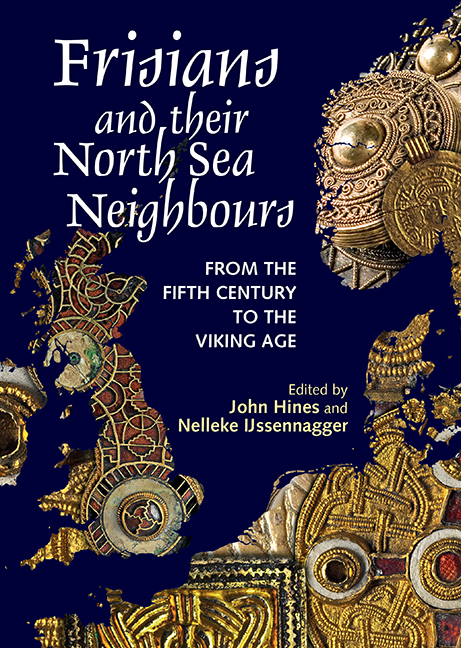Book contents
- Frontmatter
- Contents
- List of Figures
- List of Tables
- Preface
- Acknowledgements
- Linguistic Conventions and Abbreviations
- Abstracts
- Introduction: Frisians – Who, When, Where, Why?
- 1 Palaeogeography and People: Historical Frisians in an archaeological light
- 2 The Anglo-Frisian Question
- 3 Frisian between the Roman and the Early Medieval Periods: Language contact, Celts and Romans
- 4 ‘All quiet on the Western Front?’ The Western Netherlands and the ‘North Sea Culture’ in the Migration Period
- 5 Power and Identity in the Southern North Sea Area: The Migration and Merovingian Periods
- 6 How ‘English’ is the Early Frisian Runic Corpus? The evidence of sounds and forms
- 7 The Geography and Dialects of Old Saxon: River-basin communication networks and the distributional patterns of North Sea Germanic features in Old Saxon
- 8 Between Sievern and Gudendorf: Enclosed sites in the north-western Elbe–Weser triangle and their significance in respect of society, communication and migration during the Roman Iron Age and Migration Period
- 9 Cultural Convergence in a Maritime Context: Language and material culture as parallel phenomena in the early-medieval southern North Sea region
- 10 The Kingdom of East Anglia, Frisia and Continental Connections, c. ad 600–900
- 11 A Comparison of the Injury Tariffs in the Early Kentish and the Frisian Law Codes
- 12 Cultural Contacts between the Western Baltic, the North Sea Region and Scandinavia: Attributing runic finds to runic traditions and corpora of the Early Viking Age
- Index
Preface
Published online by Cambridge University Press: 25 August 2018
- Frontmatter
- Contents
- List of Figures
- List of Tables
- Preface
- Acknowledgements
- Linguistic Conventions and Abbreviations
- Abstracts
- Introduction: Frisians – Who, When, Where, Why?
- 1 Palaeogeography and People: Historical Frisians in an archaeological light
- 2 The Anglo-Frisian Question
- 3 Frisian between the Roman and the Early Medieval Periods: Language contact, Celts and Romans
- 4 ‘All quiet on the Western Front?’ The Western Netherlands and the ‘North Sea Culture’ in the Migration Period
- 5 Power and Identity in the Southern North Sea Area: The Migration and Merovingian Periods
- 6 How ‘English’ is the Early Frisian Runic Corpus? The evidence of sounds and forms
- 7 The Geography and Dialects of Old Saxon: River-basin communication networks and the distributional patterns of North Sea Germanic features in Old Saxon
- 8 Between Sievern and Gudendorf: Enclosed sites in the north-western Elbe–Weser triangle and their significance in respect of society, communication and migration during the Roman Iron Age and Migration Period
- 9 Cultural Convergence in a Maritime Context: Language and material culture as parallel phenomena in the early-medieval southern North Sea region
- 10 The Kingdom of East Anglia, Frisia and Continental Connections, c. ad 600–900
- 11 A Comparison of the Injury Tariffs in the Early Kentish and the Frisian Law Codes
- 12 Cultural Contacts between the Western Baltic, the North Sea Region and Scandinavia: Attributing runic finds to runic traditions and corpora of the Early Viking Age
- Index
Summary
To celebrate the twentieth anniversary of the First International Symposium on Frisian Runes and Neighbouring Traditions, which met in January 1994 at the Fries Museum (Museum of Friesland) in Leeuwarden (The Netherlands), a second international conference devoted to the early-medieval Frisians and their neighbours was organized with a wider remit: to combine and integrate discussions of archaeology, history, historical linguistics, legal history and palaeogeography, as well as runology. The conference Across the North Sea: North Sea Connections from ad 400 into the Viking Age was held in the new premises of the Fries Museum in Leeuwarden from 5 to 8 June 2014.
Over the course of the twenty years from 1994 to 2014 many new insights had been gained that merited discussion in an international and multidisciplinary context, with a new generation of scholars able to contribute substantially. Although again held at the Fries Museum, the conference took place in the entirely new museum building that had been opened in the heart of Leeuwarden, the capital of Friesland, a province of the modern Netherlands, in 2013.
Both the new museum and this early major conference provided the opportunity to take stock of the status quo in research concerning the enigmatic Frisians, and related peoples and areas, in various disciplines. It also provided an opportunity for the collective exploration of possibilities, problems, lacunas and pressing issues for future scholarship, with the express purpose of stimulating and launching a new and effective round of research into Early Medieval Frisia. The multidisciplinary, international character and diachronic scope of the conference sought to promote a fully cross-disciplinary approach to enable understanding of the field to break free of over-specialized and constrained perspectives.
This publication is just part of the harvest of this event, and is intended to advance the appreciation of the long-distance and maritime contacts that were fundamental to the flourishing of the Frisian identity and culture throughout this period. By publishing a selection of papers that reflect the topics and current developments in them in English, making some discussions and data available to an international readership for the first time, we aim to stimulate the international study of the topics.
- Type
- Chapter
- Information
- Frisians and their North Sea NeighboursFrom the Fifth Century to the Viking Age, pp. xiiiPublisher: Boydell & BrewerPrint publication year: 2017

